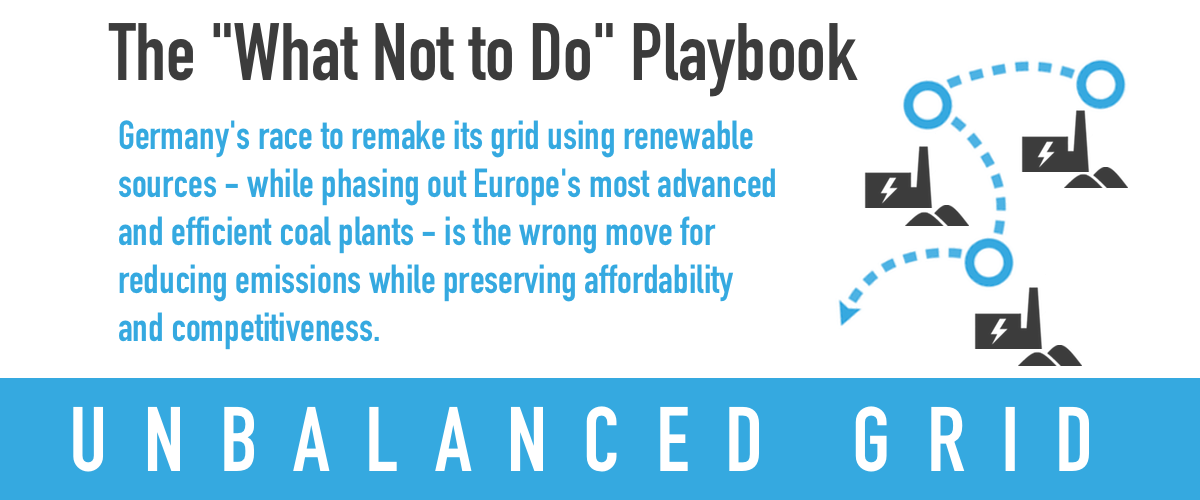
The German Misstep
Strong voter support for an all-of-the-above energy strategy in the U.S. – as identified in recent Morning Consult polling – is undoubtedly informed by experience. Just ask Xcel Energy customers dealing with record subzero temperatures this week who were asked to turn their thermostats down to 55 degrees to prevent widespread natural gas outages in the area. But along with firsthand experience, learning from the mistakes and misadventures of others helps too. And no country is providing a better learning opportunity than Germany.
The German Energiewende – while admittedly still popular with German voters – is an extreme case study in a lack of balance. Germany’s race towards a grid dominated by renewable sources of powers appears to be a playbook on exactly what not do for those that want to reduce emissions but preserve affordability and competitiveness.
The latest chapter of the German energy transition will include a proposed phaseout of the nation’s coal fleet, long the bulwark of Germany’s famed industrial base. A commission tasked with charting the course for this shift away from coal has proposed closing all 42 gigawatts of coal capacity by 2038, a fleet of plants which currently meets 40 percent of Germany’s power needs. Under the plan, coal capacity will fall to 30 GW by the close of 2022 and 17 GW by the end of 2030.
Germany’s renewables ambition has already come with a steep price tag. German electricity prices are the most expensive in Europe – an exceedingly high bar – and this effort promises to add fuel to the fire.
Germany’s coal fleet includes some of the most advanced and efficient coal plants in the world and the affordable, secure and reliable power provided by these plants has been an economy-saving counterweight to the exorbitant costs inflicted by the wind and solar build out. Should the commission’s proposal become law, that counterweight will be long gone and the uncertainty of what will come next carries all the excitement and morbidity of watching a train wreck unfold in slow motion.
Tallying the Costs
The known costs of the coal phaseout at this early stage are astounding but they will likely pale in comparison to the final tab. The commission has recommended the federal government provide the four German states home to the German coal industry 40 billion euros ($45.7 billion) over 20 years to aid in industrial restructuring, including retraining and job creation for former miners. The domestic lignite industry in Germany supports roughly 60,000 jobs and many of those, a “significant number” according to the chief executive of the utility RWE, will be gone by 2023. Despite the proposed aid, there’s the very real possibility that this grand effort won’t even work.
Along with the cost of industrial restructuring, the commission also calls for spending 2 billion euros per year after 2023 to subsidize grid charges for households and soften what many consumers fear will be major electricity price increases. Just how much prices will rise remains to be seen, but the toll could be cripplingly steep.
Dietar Woidke, the minister president of the state of Brandenburg, warned that sky-high electricity prices could nearly double. Germany already has a scheme in place to compensate energy-intensive industries for the loss of cheap power and this too will need to be developed further.
Germany’s goal is to replace its coal capacity with wind and solar generation, which are set to meet 65 percent of the nation’s electricity needs by the end of the next decade. Wind and solar just surpassed coal to generate the largest share of the nation’s power. Germany’s remaining energy needs will be increasingly met by energy imports, including a growing reliance on Russian natural gas and Vladimir Putin.
It remains to be seen if Germany can pull off this transition. Even the best-laid plans regularly don’t survive contact with the enemy, and in this case that enemy is the ever-mounting costs of this effort and the repercussions that are sure to reverberate through the German economy.
Not only will Germany face the challenge of compensating its coal industry and replacing its most affordable and reliable source of power, but the cost of integrating renewable sources of energy onto the grid only climbs as their percentage of the electricity mix increases. Balancing the peaks and troughs of generation provided by intermittent sources of energy is a unique engineering challenge unto itself. The prospect of a surge in electricity demand driven by the electric vehicle revolution adds but another variable into an impossibly complex situation.
“The whole world is watching how Germany – a nation based on industry and engineering, the world’s fourth largest economy on our planet – is taking the historic decision of phasing out coal,” boasted Johan Rockström, director of the Potsdam Institute for Climate Impact Research, to The New York Times.
Johan is absolutely right. The world is watching, and so far Germany’s grand experiment has all the makings of a calamitous misstep not to be repeated.
- On January 30, 2019
